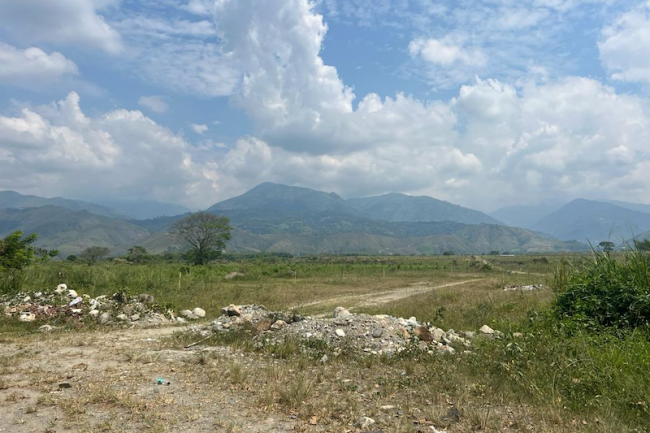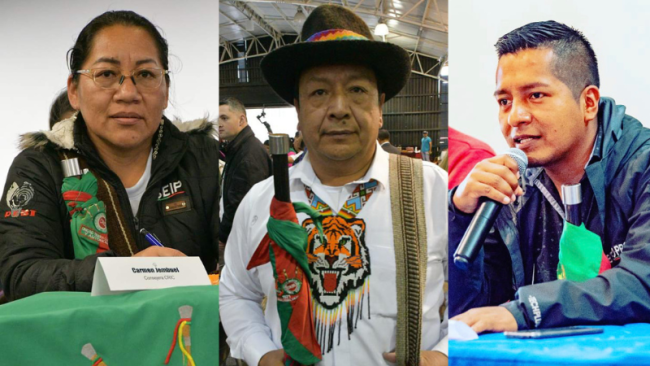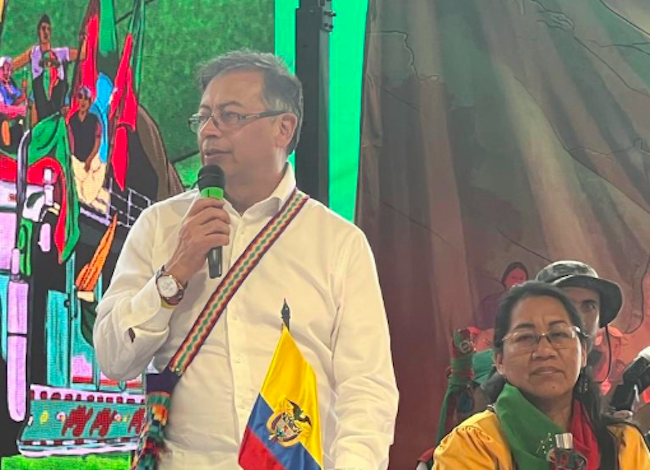
This piece appeared in the Spring 2023 issue of NACLA's quarterly print magazine, the NACLA Report. Subscribe in print today!
Leer este artículo en español.
As Colombia’s first leftist national government got underway in August 2022, Indigenous communities in the southwestern Cauca department’s sugarcane-growing regions sent the administration a clear message: they reclaimed privatized lands through direct occupation. Like other Indigenous, campesino, and Afrodescendant movements, their territorial takeovers ramped up pressure in support of their longstanding demands for land reform. Within weeks, the Petro-Márquez government promised to take steps toward agrarian reform, but also called for an end to the “invasions,” echoing the language of the powerful cattle ranchers’ union.
The Regional Indigenous Council of Cauca (CRIC), the most prominent Indigenous movement in Colombia, was quick to respond. In a statement, the movement condemned the government for trying “to fragment the proposal for a new country…in which everyone fits.” They recalled the Indigenous lives lost in the “constant struggle” to defend and reclaim land from the real “invaders.” Concentrated in the hands of a small elite, land ownership in Colombia is highly unequal, and the issue is at the root of generations of social, political, and armed conflict.
Just months earlier, ahead of the June 2022 presidential runoff, CRIC had mobilized a mass movement in support of Gustavo Petro and Francia Márquez’s winning ticket. The previous year, the movement was central in the historic protests, known as the estallido social, that rejected politics as usual. Among other demands, CRIC’s massive caravans, known as Mingas, have denounced the persistent violence against Indigenous communities and social leaders in the wake of the 2016 peace accords with the FARC. In 2022, 47 of the 216 human rights defenders murdered in the country were Indigenous.
Founded in 1971, CRIC was Colombia’s first Indigenous organization. It represents most Indigenous peoples and communities in Cauca, working directly with 139 grassroots authorities. Over the decades the organization has become a major national actor, coordinating with other social movements to fight against the inequality and violence that has plagued the country for generations.
In January of 2023, we spoke with three CRIC leaders known as consejeros/consejeras mayores. Carmen Gembuel Quiguanas, from Pueblo Misak, represents the Council of Traditional Indigenous Authorities of Eastern Cauca (COTAINDOC). Ancizar Majin Tintinago represents Pueblo Yanakuna. Eduin Capaz Lectamo, from the Pueblo Nasa, is a representative of the Association of Indigenous Cabildos of Northern Cauca-Çxhab Wala Kiwe (ACIN-CWK). While their expectations for the new government are high, they are also pragmatic, recognizing that transformative change will likely only come through ongoing pressure and mobilization from below.
This conversation, translated from Spanish, has been edited and reorganized for length and clarity.

Tell us a bit about the history of CRIC.
Ancizar Majin Tintinago: We have been in this struggle of resistance and pursuing structural change for 51 years. Our work has long been about organizing the struggles of different peoples, and we, the Indigenous people of Cauca, consider ourselves the pioneers of resistance and political-organizational leadership in Colombia. Now the Black communities and campesinos are also organizing. In fact, many organizations have followed the lead of CRIC, such as the Guardia Indígena, Guardia Cimarrona, Guardia Urbana, and Guardia Campesina.
[EXPLAINER: As described on CRIC’s website, the Guardia Indígena or Indigenous Guard is a civil society organization that works to maintain Indigenous autonomy through the defense of their territories and forms of life. Its unarmed members conduct peaceful actions, carrying only a bastón de mando, a staff of authority. In recent years the Indigenous Guard has inspired other projects of peaceful community resistance, such as the Guardia Cimarrona, organized by Afrodescendant communities of Cauca. Cimarrón refers to enslaved Africans who escaped and created autonomous communities.]
It is not easy for popular social classes to reach the state because the laws, constitutions, and judicial system are not made for the pueblos, they are made for the elites, for the families who have always governed. Making that transition to the people being involved in governing a country is not easy. That is why it is necessary to walk toward the creation of plurinational states, because we have always, since the beginning of colonialism, been pushed out of participating in the traditional western governmental systems.
We would like to hear about the common ground and differences between grassroots organizing and electoral politics. Before the 2022 presidential elections, what was the relationship of CRIC to the candidates Gustavo Petro and Francia Márquez, and to their proposals?
Eduin Capaz Lectamo: Both Petro and Francia have a similar life trajectory to that of many leaders of Indigenous peoples and social organizations in the country. Petro was a militant in the M-19 [guerrilla movement, demobilized by 1990]. He was in Indigenous territories, and in many parts of his life he was influenced by Indigenous people. He confessed to us in one of our encounters, before becoming president, how he had passed through our territories when he was a guerrilla, through Mosoco, in Tierradentro. He was also in areas of the northern part of Cauca, in Corinto.
Francia Márquez has been close to the struggle of the pueblos afrocolombianos in the municipality of Buenos Aires, one of the 13 municipalities of northern Cauca, which has a unique context of Indigenous peoples and campesinos, as well as struggles over land and to stop the expansion of gold mining, particularly in Buenos Aires and Suárez. The struggle for the land has involved both Afro-Colombian and Indigenous communities.
So these two figures have life experiences that profoundly connect them to the Cauca social movements, both Indigenous and Afrodescendant.

The social uprising of 2021, referred to as the estallido social, marked a turning point in Colombian politics. What was the role of CRIC and other organizations and how might that have contributed to the victory of Petro and Márquez?
ECL: There have been alternative political proposals being developed for a long time, and these proposals have always emerged through the process of mobilization. These proposals have brought together all of southwest Colombia and the entire country on different occasions. For example, the Minga Social of southwestern Colombia was an important moment of articulation between the Indigenous struggle and the struggles of campesinos, Afrodescendants, and other social sectors. Then there was the Minga Indígena y Popular at a national level, which was also a space that developed social and political proposals involving different sectors. All of these processes have had a strong correlation with the creation of an alternative vision of the country that the Petro government, in one form or another, has taken up.
Our participation in the estallido social was strong and direct. Our participation was tied to the transformation of the social uprising into participation at the polls to make a change. We added our voice to many other voices. This happened first in the congressional elections [of March 2022], in which we won three representatives.
And then came the elections [of May and June 2022] that carried Gustavo Petro and Francia Márquez to the presidency and vice presidency. There was a lot of work prior to that. We went to the cities, we worked all night, we were drenched by the rain. And what did we do? Caravans. We went through the cities educating people about why the elections mattered. CRIC did not just sit quietly given the challenge of the moment. We were called upon as important figures to participate actively, proactively. And it happened. Despite all the difficulties, we did it.
After Petro and Márquez’s victory, another historic moment occurred when Indigenous organizations were invited to meet with Petro’s team as part of the empalme, a series of meetings, tied to the presidential transition, with powerful sectors of Colombian society. CRIC’s councilors also met Petro personally. Can you tell us about that encounter?
AMT: We met in the Nariño [Presidential] Palace with Petro to converse government to government. We told Petro that, as long as the rights of the pueblos in Colombia are moving forward, we will support him. But if things go backward, we will have to resort to our traditional forms of struggle and resistance. The Regional Indigenous Council of Cauca will never lower its flags, its symbols, or the way it has been resisting for these 51 years. Why? It is true that Gustavo Petro is an alternative president, a progressive. But that does not offer any absolute guarantees that the rights for which we have been fighting for centuries will materialize automatically.
Colombia is a complex country. Not only must Indigenous organizations mobilize to defend their rights vis-à-vis the state, but there are also complex relations with other social actors and organizations. One of the main issues is land reform and the demands for land from campesino communities, Afro-Colombian communities, and Indigenous organizations. Not to mention the role of the cattle ranchers and large farmers. Can you tell us about these relationships and how they relate to the current conjuncture?
AMT: We all long for total peace. But it is hard to dialogue with all the diverse groups in Colombia, even the drug traffickers. It is very difficult, even though we have a lot of experience that allows us to sit down, converse, make agreements, and look for solutions, all of which are absolutely necessary.
Read the rest of this article, available open access for a limited time.
Virginie Laurent is a professor of Political Science at the Universidad de los Andes in Bogotá.
Bret Gustafson is a co-executive editor of NACLA and a professor of Anthropology at Washington University in St. Louis.

